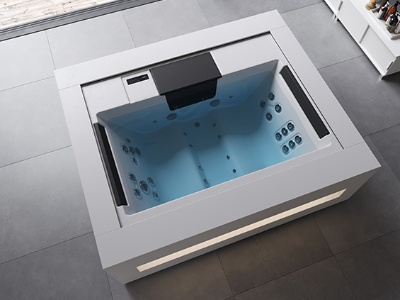
Installing an automatic cover for your swimming pool is a decision that brings many advantages: increased safety, reduced water evaporation, protection against impurities and energy savings. However, to get the most out of this investment, it is crucial to take several criteria into account before making your choice. This guide will help you assess the key points when choosing the automatic cover that best suits your pool.
Why choose an automatic cover?
Unlike conventional tarpaulins, automatic covers offer a practical and durable solution to protect your pool. They are operated by an electric or hydraulic motor, allowing for easy, effortless opening and closing. Their main advantage is their ability to ensure optimal safety, in particular by preventing access to young children, making them compliant with mandatory safety standards. 1. The type of automatic cover There are several types of automatic covers, each with its own specific features:- The above-ground roller shutter: Easy to install, it rolls up around a motorised shaft located at the edge of the pool.
- The submerged roller shutter: More discreet, it is installed below the waterline and remains invisible when rolled up.
- The automatic tarpaulin: More affordable, it unrolls mechanically over the water and can be fixed to the coping. The choice of model depends mainly on your needs in terms of aesthetics, budget and integration into your pool. 2. Compatibility with your pool Before installing an automatic cover, it is important to check its compatibility with your pool. Some models require a dedicated space for the installation of the motor and the winding system. If your pool is already built, an above-ground cover will be easier to install, while an in-ground cover is preferable for new builds. The shape and size of the pool also influence the choice of cover. Rectangular pools are best suited to automatic covers, while free-form pools require customised solutions, which are often more expensive.
3. The motorisation system
Automatic covers operate either with an electric motor or a hydraulic system. The electric motor is the most common and the easiest to maintain. It generally operates on a 24V or 220V power supply and can be controlled via a remote control or a wall switch.
Hydraulic systems, although more robust, require a specific connection and more extensive maintenance. They are often used for high-end covers and installations requiring high weather resistance.4. The strength and durability of the materials
The longevity of an automatic cover depends directly on the materials used in its manufacture. Roller shutter slats can be made of PVC, polycarbonate or aluminium. Polycarbonate, although more expensive, offers better resistance to impact and UV rays, thus reducing the risk of premature deterioration. Automatic tarpaulins, on the other hand, must be treated against UV rays and chlorine to prevent rapid wear and tear. It is also recommended to opt for stainless steel fixings to prevent corrosion in humid environments. 5. Maintenance and ease of use One of the main advantages of automatic covers is their ease of use. However, to ensure they work properly in the long term, regular maintenance is necessary. Here are a few recommendations:- Clean the slats of the shutter regularly to prevent the build-up of algae and debris.
- Check that the motor is working properly and lubricate the axles if necessary.
- Check the condition of the fastenings and make sure that no part shows any sign of corrosion.
6. The budget to be planned for
The price of an automatic cover varies according to the type of product, the materials and the motorisation. On average:
• An above-ground roller shutter costs between 3,000 and 6,000 euros.
• A submerged cover costs between 6,000 and 12,000 euros.
• An automatic tarpaulin can cost between 2,000 and 5,000 euros.
These prices generally include installation, but it is always best to ask for several quotes to compare the offers. In the long term, an automatic cover saves money on pool maintenance, water consumption and chemicals, making the investment profitable. Choosing an automatic cover should not be taken lightly. It is important to consider compatibility with your pool, the type of motorisation, the materials used and the available budget. Once properly installed and maintained, it will become a major asset for the safety and durability of your pool, while offering unparalleled ease of use.




